14K vs 24K Gold: Which Karat Should You Choose?

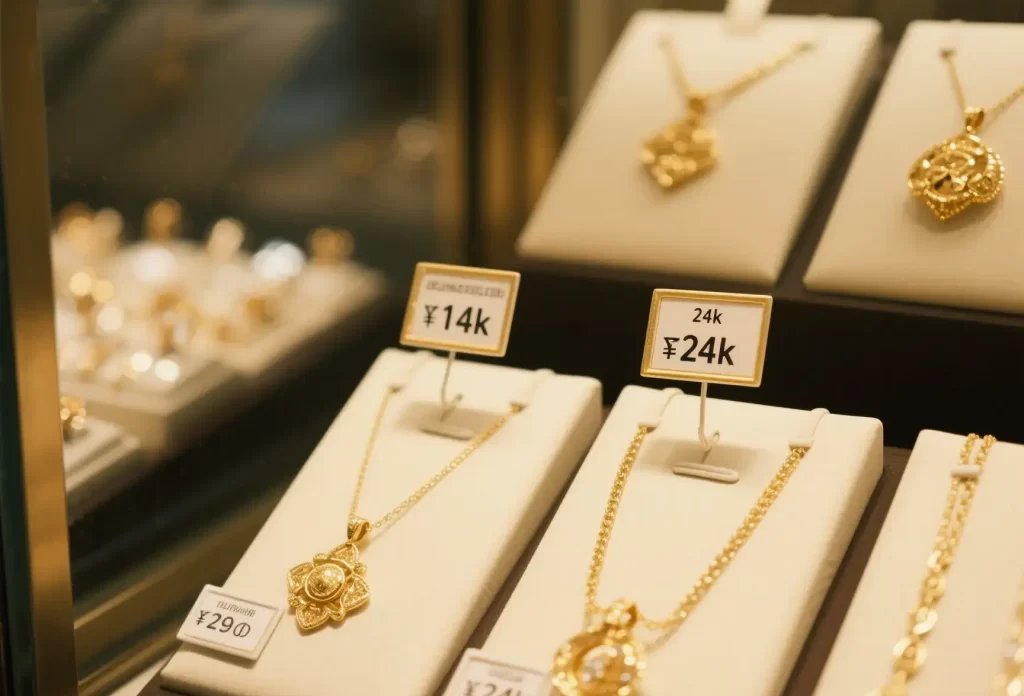
Key Takeaways
- Karat is a measure of gold purity. For instance, 24k is pure gold, and 14k is 14 parts gold, or approximately 58% gold, with the other metals added to make it stronger.
- 14k gold is more durable and affordable, and as a result, is the most popular choice for everyday jewelry in the United States.
- 24k gold has a brilliant deep yellow hue and is the most valuable. Unfortunately, this very softness is what makes it perfect for use in only the most special occasions or ceremonial pieces.
- Consider your personal lifestyle, budget, and skin sensitivity when choosing between 14k and 24k gold. Many women find that the alloys in 14k gold are more likely to cause allergic reactions.
- With the proper care and regular cleaning, 14k and 24k gold jewelry will look beautiful for years to come.
- When purchasing gold, always buy from a reputable jeweler and look for ethical sourcing to ensure quality and responsible purchasing.
The only difference between 14k vs 24k gold is the percentage of pure gold. 14k gold has 58% pure gold alloyed with other metals, whereas 24k gold is nearly 100% pure.
In the USA, consumers tend to prefer 14k gold for their jewelry. It holds up to everyday wear and is less expensive than 24k gold. While 24k gold has a much brighter and richer hue, it is much softer and thus more prone to scratching.
Consumers have to consider both the value and how each gold feels or wears. To make the right decision, it’s useful to understand how each type lines up with your preferences, finances, and needs. The remainder of this post unpacks these important themes and what they mean for you.
What Does Gold Karat Mean?
Gold karat is the most common, and basic, standard to use when discussing the purity of your gold jewelry. This number indicates the percentage of real gold that is alloyed with a piece, with 24 karat being 100% gold.
The remainder is made up of other metals such as copper, silver, and zinc. Each karat stamp indicates what percentage of the piece is gold and what is alloy, allowing you to know its value.
For example, the gold jewelry you buy in the U.S. Now is typically stamped with its karat, like 14K or 18K. This can be especially helpful if you decide to check the value or resell the piece.
Karat is a measure of purity, not weight—carat, with a “c,” is the unit of weight for gemstones.
Understanding Gold Purity Measurement

Gold purity is measured using the karat scale, with 24K gold being 99.9% pure gold. That’s because the more alloy that’s mixed in, the lower the karat.
Here’s how it breaks down: 24K is pure, 18K is 75% gold, 14K is 58.3%, and 10K is 41.7%. You might recognize these stamps on gold rings, necklaces, and bracelets.
Understanding how gold purity is measured is important. It helps steer what makes sense for everyday wear or cherished mementos.
Pure 24k Gold Composition Facts
Pure Gold Composition 24K gold is as close to pure gold as you can get. Fundamentally, pure gold is malleable, bends easily and has a bright yellow color.
Its softness makes it rare as jewelry for everyday wear, because it’s easily scratched and bent out of shape. Most consumer purchases of 24K gold are in the form of bars or coins for investment purposes.
This purity increases its value and price.
What Alloys Create 14k Gold?
14K gold is an alloy that combines gold with copper, silver, and sometimes zinc. These alloys introduce durability and hue, providing 14 karat gold with a delicate, pale yellowish or rose tint.
14K gold would therefore be 58.3% pure gold. It’s durable, stands up to everyday wear and tear, and is much less expensive than higher karats.
That’s US jewelry’s number one choice for a reason. HonHo Jewelry in China produces custom waterproof and gold-filled pieces with these blends.
Quick Look: 10k and 18k Gold
|
Karat |
Gold Content (%) |
|---|---|
|
10K |
41.7 |
|
14K |
58.3 |
|
18K |
75 |
10K gold is the strongest and most affordable of the golden shades. While 18K gold is deeper in color, it is more expensive and softer on the Mohs scale of hardness.
10K tends to be used for more affordable jewelry. 18K is chosen for significant presents. The higher the karat the more gold content, but the less durable the jewelry will be.
14k vs 24k Gold Showdown
When weighing 14k against 24k gold, it’s helpful to know how each one stands up in purity, strength, color, and cost. These important attributes really count when you’re buying jewelry or considering overall value over time. The optimal selection is really a matter of what works best for you, your aesthetic, and your wallet.
Read on as we unpack each consideration. We hope this gives you a better idea of 14k vs 24k gold compared in real life and in the marketplace.
1. Purity: The Pure Gold Difference
The biggest line drawn between 14k and 24k gold is purity. 24k gold is 24 karat gold, or 100% pure gold, with no other metals combined. In contrast, 14k gold consists of 58.3% pure gold, with the remainder made up of common gold alloys like copper, silver, and zinc. This alteration in composition not only changes the color but also affects the durability of the gold.
We know that pure gold has the highest price point and features the deepest, richest yellow color that immediately catches everyone’s attention. As you increase in gold purity levels, there are some trade-offs to consider. Pure gold is softer, making it more susceptible to nicks and bends, which can be a concern for those seeking a perfect engagement ring.
While this makes 14k gold less pure, the addition of other metals enhances its resistance to the daily blows of wear and tear. For fine jewelry that you want to wear every day, such as a wedding ring or a bracelet, understanding the actual gold content can matter greatly.
People who want a show of wealth or tradition might lean toward 24k, especially in cultures where gold meaning and purity are paramount. That’s why in the U.S., most shoppers prefer the right gold type, often opting for 14k gold, which provides a perfect blend of durability, splendor, and reasonable cost.
2. Strength: Which Withstands Daily Life?
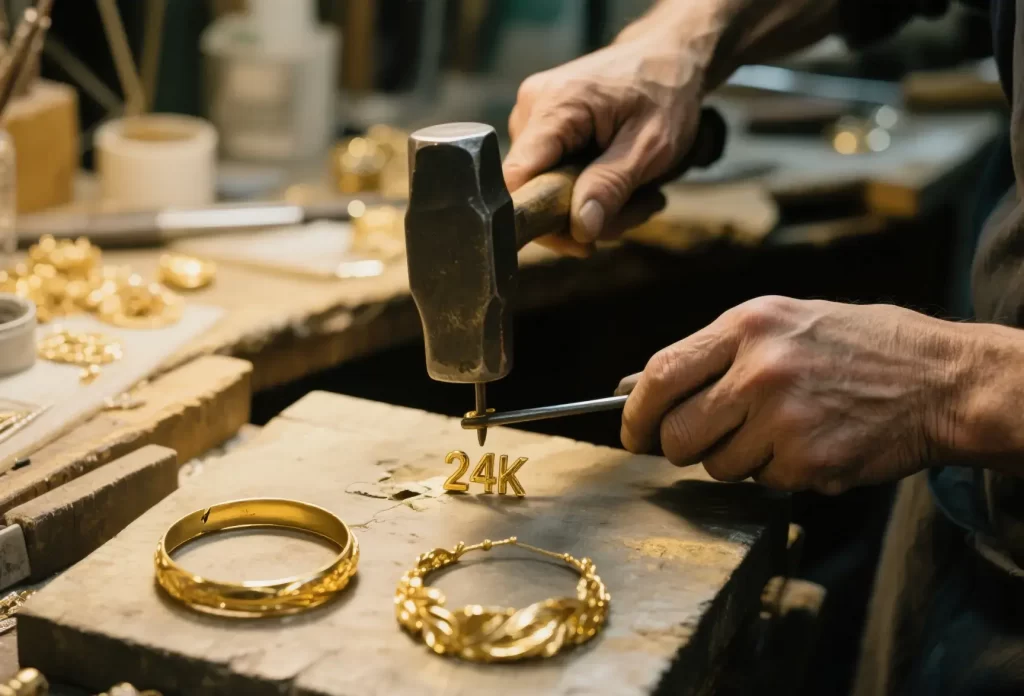
Perhaps 14k gold’s most attractive features are its strength. Those additional metals go a long way to making 14k gold significantly more durable than 24k. This translates to 14k gold rings, earrings, and necklaces not scratching or denting as easily.
This is why you are likely to see 14k gold more in everyday pieces. That’s why it’s such a popular choice for engagement rings and wedding bands.
24k gold is beautiful, yes, but it’s very soft. It becomes easily malleable, bending and scratching with just a finger’s pressure. That’s why you won’t see 24k gold in rings or bracelets intended for everyday wear in Western markets.
Bangles or pendants made of 24k gold are ideally worn on special occasions or stored as heirlooms rather than being incorporated into everyday life. If you need jewelry that can withstand the test of an active lifestyle, 14k gold is the wiser choice.
For jewelry that remains hidden away or is worn just on special occasions, 24k gold shines out. It does need a very delicate hand to stay at its most beautiful.
3. Color: Rich Yellow vs Softer Hues

24k gold showcases a rich, warm yellow that really pops. Recalling the color of the sun, yellow is a hue frequently associated with opulence and heritage, particularly in cultures such as Indian or Chinese.
The softer golden hue 14k gold is known for is due in part to the blend of metals used with 14k gold. This allows jewelers to customize colors, creating rose gold or white gold by adding copper or nickel.
As far as color is concerned, if you are looking for that quintessential yellow gold, 24k gold offers the boldest appearance. If you like a pale gold or want to match your jewelry to a certain outfit or skin tone, 14k gives more options.
Either option complements the appropriate setting beautifully, from an eye-catching effect to a more understated glimmer.
4. Feel: Weight and Density Compared

Gold’s density varies depending on purity. Heavier Density-wise, 24k gold is noticeably heavier. This heft conveys a feeling of quality but can feel cumbersome in large designs.
14k gold is lighter, so larger designs don’t weigh down your wrist or neck. Some prefer the heft of 24k gold, as it feels more substantial and opulent.
Some people really enjoy the feel of 14k, particularly in a ring or hoop earring that will be worn all day long. The weight affects how you perceive the value—heavier usually feels more “authentic,” but comfort is important as well.
5. Allergies: Skin Sensitivity Factors
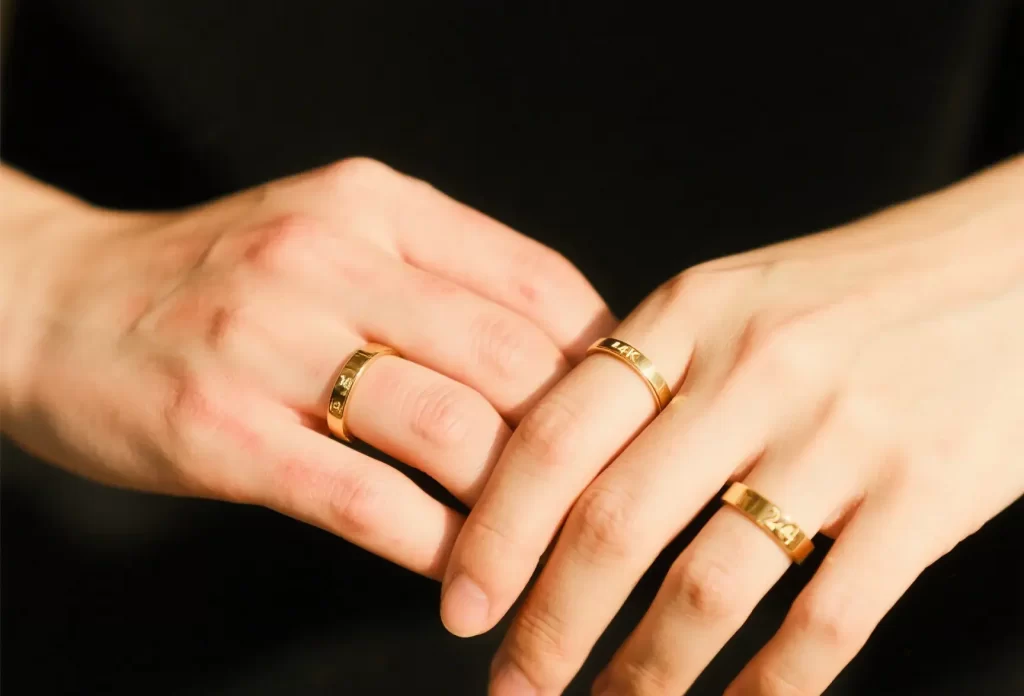
The risk of an allergic reaction or skin irritation is legitimate. 14k gold, due to its extra metals, can lead to allergic reactions in those sensitive to copper, nickel, or zinc. Others may experience redness or itching after wearing 14k gold for extended periods of time.
24k gold typically doesn’t create this reaction since, being pure gold, it contains no other metals. If you’re prone to skin irritation, 24k gold is the better choice.
Whatever you decide, though, it’s wise to test out a small piece before making a commitment. This prevents an adverse reaction from occurring while allowing you to wear and enjoy your jewelry longer.
6. Cost: Price Point Realities
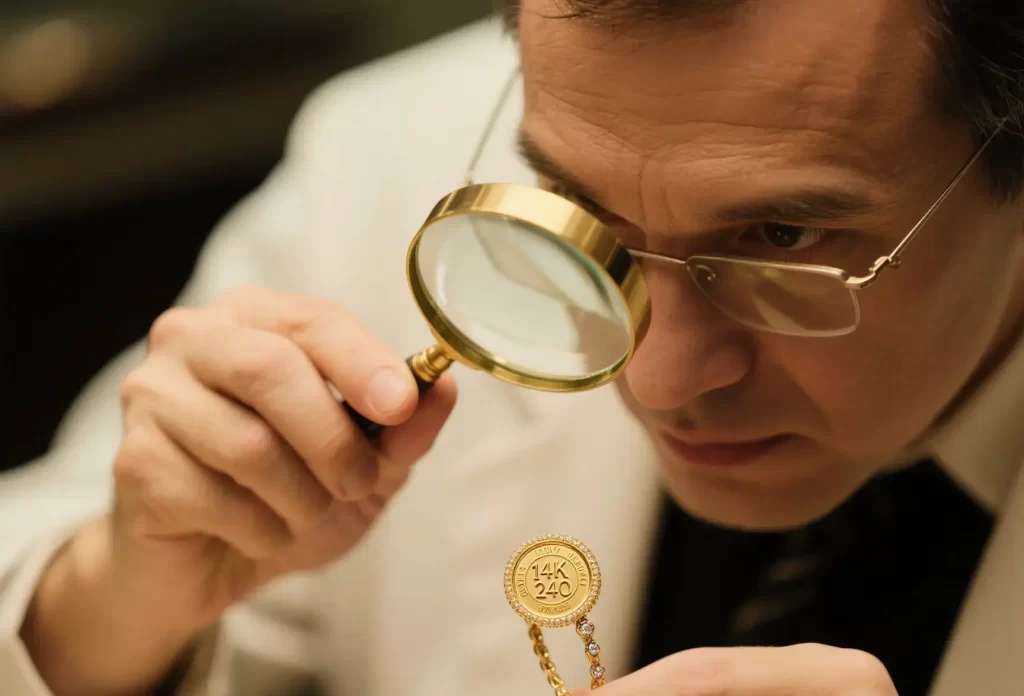
14k gold is significantly less expensive. Its price is a direct result of its purity and the worldwide demand for gold. Fortunately, 14k gold is much more budget-friendly and still beautiful.
That’s one of the reasons it’s so ubiquitous in U.S. Jewelry stores. When gold prices increase, both kinds become more expensive, but the increase is larger for 24k gold.
If you’re shopping with price in mind, 14k usually is the smarter choice. It provides you with the appearance of gold without the high cost, and it lasts longer.
7. Value: Investment vs Practicality
When it comes to investment, 24k gold is the clear winner. It’s easy to resell and can often be resold at a premium. The average person purchasing 14k gold is doing so to wear it every day—not to hide under a mattress.
14k gold more successfully retains its value in terms of wear and aesthetic, where the 24k gold is solely concerned with purity and display of wealth.
Whatever your lifestyle—creative, active, formal—let that inform your decision. If you’re looking for something to pass down or resell, 24k is a good choice.
If you want a new ring or bracelet to wear every day, 14k gold is more practical and can still be trendy.
If you are planning to wholesale jewelry, visit HonHo Jewelry Manufacturer in China. They are known for customizing even more alternative materials such as stainless steel, brass and 925 silver.
With more than 15 years of experience, they produce outstanding designs suited for the most discerning tastes. There, they got into designing waterproof, non-tarnish, gold vermeil, and gold-filled collections.
Why Choose 14k Gold?

This makes 14k gold a reliable choice for anyone seeking to find the perfect blend of style, function, and value in one package. It combines deep, vibrant color with excellent resilience, all while remaining accessible to nearly any budget. Across the United States, jewelry stores, as well as online retailers, will happily display 14k gold.
Its quality and value combination is rightfully popular among shoppers. It’s versatile enough to suit all aesthetics from vintage to contemporary, and perfect from everyday occasions to your big day. Shoppers looking for something in between the intense luster of 24k gold and more durable lower karats usually gravitate toward 14k gold as the perfect middle ground.
That’s because it perfectly balances beauty and strength.
Everyday Durability Advantage
Everyday Durability Advantage 14k gold stands up to the daily grind and its dings. Its alloy of metals, including 58.3% gold, gives it a strength far superior to 18k or 24k gold jewelry. Rings, bracelets, and chains made in 14k gold will continue to look beautiful even after years of wear.
If you live an active lifestyle or have a profession that has your hands working often, 14k gold is a durable option. It’s an everyday durability advantage. It’s hard to beat for wedding bands, everyday studs, and watches.
More Affordable Gold Option
More Affordable Gold Option Cost is always a consideration, and 14k gold is usually much more economical than 18k or 24k. It provides that luxe gold aesthetic without the luxe price point. This quality makes it wonderful for presents or important occasions such as engagements.
Jewelry creators, such as HonHo Jewelry Manufacturer in China, offer a fun array of 14k gold-filled and gold vermeil jewelry. This allows buyers greater flexibility to select the best option to meet their specific needs.
Versatile Color Choices Available
14k gold is available in yellow, white, and rose colors. This spectrum is the result of combining gold with alloys such as copper or silver. Some customers adore the understated, pale gold appearance, while others gravitate toward the rose, or even more vibrant yellow.
Since 14k offers so many styles, you can choose a look that fits your personal aesthetic—from stackable statement rings to eye-catching pendants to elegant hoops.
Popularity in US Jewelry Trends
Popularity in US Jewelry Trends In the U.S., 14k gold is all around, from your top-tier chain stores to your favorite local makers. It’s the most popular choice for engagement rings due to its price-to-durability ratio.
More recently, it has developed not only a reputation for value but for being the sensible choice in US jewelry. By opting for 14k, you’ll be following a proud and long history of intelligent consumers.
When is 24k Gold Better?

In our experience, there are two occasions when 24k gold, known for its stunning diamond engagement ring appeal, is clearly the superior choice. With its rich gold color and unequaled worth, this pure gold alloy serves needs that extend past everyday fashion, impacting design decisions and cultural significance.
Maximum Purity and Rich Color
24k gold is as pure as it gets—pure gold, with no alloys, making it the perfect gold option for those seeking the highest quality. This imparts to it a vivid, flamboyant yellow that’s impossible to overlook. Artistic expression is a key aspect of why fine jewelers tend to use 24k for their statement jewelry, including stunning diamond engagement rings. The deep color catches the eye and screams extravagance, making it a popular choice for wearable jewelry.
Buyers who prefer the rich gold color find that the appearance alone can be the biggest attraction. Pure gold’s classic gold appearance conveys worth instantly, which is why it remains a top choice in gold jewelry sales. 24k gold is heavily represented in high-end boutiques in Los Angeles and other large cities, working best for statement pieces intended to be show stoppers.
The color is not purely cosmetic—it significantly impacts gold purity and how everyone perceives the value of gold. From pendants to statement earrings, 24k gold remains a favored metal choice for those looking to flaunt affluence and style.
Cultural Significance and Investment
In many cultures, 24k gold has long been viewed as a sign of wealth and prosperity. Whether in weddings, festivals, or as gifts, the role of pure gold jewelry expands significantly. For instance, Asian and Middle Eastern traditions tend to prefer 24k gold for dowries and heirlooms.
Aside from that, pure gold is a great investment. 24k gold, being the purest form of gold, retains value better than lower karats and is easier to resell. This is one of the main reasons collectors and investors alike prefer 24k gold bars and coins.
Best for Occasional Wear Pieces
Since 24k gold is soft, it’s better suited for pieces that won’t be worn on a daily basis. Brooches, pins, or ceremonial necklaces would be excellent examples. These pieces retain their luster and form as they’re not subjected to much friction and movement.
For jewelry-wearers with sensitive skin, 24k gold is hypoallergenic, furthering the comfort level.
Appearance: Spotting the Difference
Spotting differences between 14k gold and 24k gold Just like many things, it’s all about knowing where to look. The keen eye can identify this change by looking for color, luster and even how the gold interacts with light. Understanding this information puts you in a better position to make a smart purchase and have the confidence that what you’re looking at is legitimate.
Getting a handle on the fundamentals before you hit the store can go a long way. It’s a guarantee that you’re only going to see things that genuinely speak to your style and your aesthetic.
Visual Luster and Shine Comparison
The luster of 14k gold is bright, rich, warm and lasting. It’s created when you alloy gold with metals such as copper, silver, or zinc. This combination results in a color that is slightly less brilliant but preserves the integrity of the piece.
While the luster is evident, it’s not as saturated or intense as solid gold. Since 24k gold is pure gold, its yellow is very bright and very rich. Though it’s dazzling with a rich, deep, attractive gloss luster, the softness gives it a beautiful appearance with a tendency to dent and scratch more easily.
Consumers seeking unique jewelry often prefer the audacity of 24k. Some people like 14k because of its more understated appearance and durability for everyday wear. The purer the gold, the yellower, shinier and brighter the hue, but the less durable and tougher it is as well.
How Lighting Affects Gold Color
How Lighting Affects Gold Color Light drastically alters our perception of color. Under sunlight, 14k has a muted yellow appearance, while 24k has a strong, vibrant yellow color. Indoors, under incandescent bulbs, they can both appear a little muted.
This is why looking at gold under various lighting conditions is key to determining its true color. The alloys in 14k can vary in color—yellow, rose, or even white, depending on the specific blend. Measuring your gold in a few different environments will help you get a clearer picture of what it really looks like.
HonHo, a Jewelry Manufacturer in China, produces beautiful gold jewelry with alloys and gold plating. They come in a wide range of colors and are available in waterproof and non-tarnish formulas.
Making Your Gold Choice
When deciding between 14k gold and 24k gold, it’s more than just appearance. It’s all about how the gold works with your lifestyle, budget, and aesthetic to create the perfect piece. Gold’s karat indicates the level of pure gold it contains.
To illustrate, 24k gold is close to 99.9% pure, and 14k gold is an alloy that mixes gold with other metals. This combination alters the color, durability, and cost of your jewelry. While some buyers may prefer gold with a bright yellow lustre, others may prefer the quiet beauty of 14k gold. Wear location and wear style factors into making your decision as well.
Match Gold to Your Lifestyle
Consider what your day-to-day life is like. If you lead a busy lifestyle, 14k or even 10k gold is ideal. These metals are much more resistant to wear and tear than higher karat metals.
For example, these types are more resistant to scratching and more durable for everyday use. 24k gold is perfect for those of us who prefer to wear jewelry just on special occasions. It’s lustrous and sumptuous in appearance, but in reality it is quite malleable and easily scratched or bent.
A person who collects gold or appreciates tradition may select 24k for the purity.
Consider Your Budget Carefully
Consider your budget before anything else. Gold prices fluctuate daily, and higher karats such as 18k and 24k are more expensive. 14k gold is a great balance of price and durability, making it the most popular gold choice for everyday jewelry.
If your budget is lower, 10k gold is very competitive and has great value. Consider how long you intend your jewelry to last and whether you want to wear it on a daily basis. Consider your budget against what you really want to buy.
Best Karat for Engagement Rings?
Strength is key when it comes to engagement rings. 14k gold is a favorite because it is very durable. 18k gold provides a richer golden color but is softer.
While some enjoy 24k gold for its pure aesthetic, 24k gold is uncommon for rings. Consider your lifestyle and taste, and wear what looks and feels amazing!
Think About Jewelry Type Use
Choose gold according to purpose and use. 14k gold is durable enough for rings, bracelets, and necklaces that you wear every day. 24k gold is more appropriate for items you don’t wear often or plan on having as investments.
Such as, for instance, heirloom bangles or wedding gifts. Everyday studs or simple bands hold up better in 14k.
Personal Style and Color Preference
Choose based on your personal style and color preference. Others prefer the deep yellow color of 24k gold. Some customers prefer the lighter gold of 14k or the deeper color of 18k.
Explore a variety of golds to find which ones are closest to your skin tone and personal style. What you like is what’s most important, and looking and feeling good in your jewelry is what it’s all about.
Caring for Your Gold Jewelry
Whether you own a stunning diamond engagement ring or a classic gold appearance piece, all gold jewelry requires special care to maintain its luster and durability. The way you care for these pieces will significantly impact their wear and age over the years. Proper care helps each gold type look its absolute best and prevents premature signs of wear, ensuring that your precious metal retains its worth.
Preventing Damage to Gold JewelryCleaning and storing gold properly will prevent scratches, bending, or tarnish from developing. Making care like this part of your everyday life will help protect your gold. This is true for beloved family heirlooms as well as recent purchases.
Keeping 14k Gold Looking Great
Scratch resistant and durable, 14k gold is durable and resists daily wear and tear. Combine mild dish soap with warm water. Next, use a non-abrasive cleaning cloth or a soft-bristled toothbrush to gently clean the entire surface. This removes accumulated dirt and maintains the gold’s luster.
Since 14k gold is highly scratch resistant and won’t tarnish, it’s less demanding to maintain that fresh new appearance. That being said, remove your rings before yard work or gym workouts. If possible, keep each piece in a soft pouch or a lined jewelry box to prevent them from scratching one another.
Rose gold, which is a 14k option, is even less maintenance because it doesn’t require replating like white gold.
Special Care for Soft 24k Gold
This is because 24k gold is pure gold, and thus soft, bending and scratching more easily. Simply clean it with a soft, damp cloth and blot it dry. Avoid abrasive chemicals and cloths; they can scratch the surface.
High impact force or hard knocks will permanently alter its shape. Store each piece in its own pouch, don’t stack it with other jewelry. Treat these pieces with extra care to maintain their exquisite beauty.
Cleaning Tips for Both Types
- Clean with warm, soapy water & soft cloth or brush.
- Dry well with a lint-free cloth.
- Avoid bleach, ammonia, or abrasive cleaners.
- For stubborn dirt, use a jewelry cleaning solution specifically designed for gold.
- Have your valuables professionally cleaned at least once a year.
- Regular cleanings every few months will help your jewelry stay bright and beautiful for years to come.
Beyond the Basics: Other Factors
Decisions like 14k vs 24k gold aren’t just a cost or sparkle decision. Other factors come into play, from how quickly things go in and out of style to what you personally value more, whether that’s aesthetics or corporate responsibility.
Gold jewelry is not simply a sign of status. It’s influenced by your lifestyle, priorities and knowledge of the current market.
Common Gold Karat Misconceptions
Misconception #1: Karat is about quality, not quantity. Most people think karats are a measure of quality. In truth, it simply indicates how much pure gold is contained in the item.
For example, while 24k gold is pure and thus has the deepest yellow color, this renders it the softest. It scratches and bends easily—great for ceremonial occasions, not for everyday use.
Conversely, 14k gold contains more alloyed metals, which increases the hardness. It’s resistant to dings and dents, which makes it suitable for rings or bracelets you might wear daily.
Myth 3: 10k gold is super durable. It’s less likely to bend or scratch, making it the ideal option for rings that will see a lot of daily use. Buyers often believe that more karats are always better, but that is not the case when it comes to durability.
Understanding these realities better equips people to make informed decisions and choose the best option for their situation.
Ethical Sourcing Considerations Today
More and more buyers demand to understand the source of their gold. Ethical sourcing considerations are at an all-time high.
Consumers are looking for jewelers who source their gold in ways that don’t negatively impact workers or the planet. Whether you ask your jeweler about their sourcing or support companies with clear sourcing policies, it all adds up to making a difference.
For instance, HonHo Jewelry Manufacturer in China specializes in custom, non-tarnish, and gold-filled pieces – all produced in accordance with responsible sourcing practices.
Choosing reputable sources increases the positive impact of your jewelry far beyond the value of the metal.
Conclusion

Choosing between 14k and 24k gold really depends on your priorities as a jewelry consumer. Looking for something durable you can casually wear day in and day out? 14k gold does that job perfectly. Interested in achieving that beautiful, luxurious gold hue or purity of product is your priority? 24k gold provides the ultimate pure gold experience and aesthetic, but remains relatively soft and susceptible to scratching.
Consider your lifestyle, your needs and preferences, and your budget. Each of them might be more appropriate for various needs. We recommend you visit a few pieces in person before making a purchase, so that you can get a sense of what works for you. Have questions or need more advice on buying gold? Get in touch or leave a comment. Sign up today and find your perfect gold fit!
Frequently Asked Questions
What is the main difference between 14k and 24k gold?
14k gold, a popular type of gold jewelry, is composed of 58.3% actual gold content alloyed with other metals, providing added strength, while 24k gold represents the purest gold at 99.9%, offering a rich gold color.
Is 14k gold better for everyday jewelry in the U.S.?
The 14k gold engagement ring is definitely more durable and scratch-resistant, making it a great metal choice for rings, bracelets, and other wearable jewelry you wear daily.
Why does 24k gold cost more than 14k gold?
That’s because 24k gold is almost completely pure, which makes it more valuable and expensive. Since 14k gold contains less gold, that fact decreases the price.
Can I wear 24k gold jewelry every day?
Wearing a 24k gold engagement ring all the time isn’t advisable due to its malleability; this soft gold type can easily bend, scratch, or lose its shape with everyday wear.
How can I tell if my gold is 14k or 24k?
To determine if your gold is 14k or 24k, look for the 14k or 585 stamp, which signifies its gold purity levels; a 24k or 999 stamp indicates the purest gold.
Does 14k gold tarnish or turn skin green?
It is very unlikely for a 14k gold engagement ring to tarnish or turn skin green, particularly when crafted with quality materials and well cared for, ensuring a rich gold color.
Which gold karat is best for sensitive skin?
Natural elements, like 24k gold, are hypoallergenic and work best for sensitive skin because they do not have mixed metals, which can impact gold purity and irritate your skin.
Related Posts

Understanding Wholesale Jewelry Pricing and How It Works
Understanding Wholesale Jewelry Pricing and How It Works When people see a ring that costs $6 wholesale and retails for $59, they often

The Art of Shine in Jewelry Polishing and Plating Techniques
Discover how polishing and plating transform modern jewelry with expert techniques for lasting shine and elegant finishes.
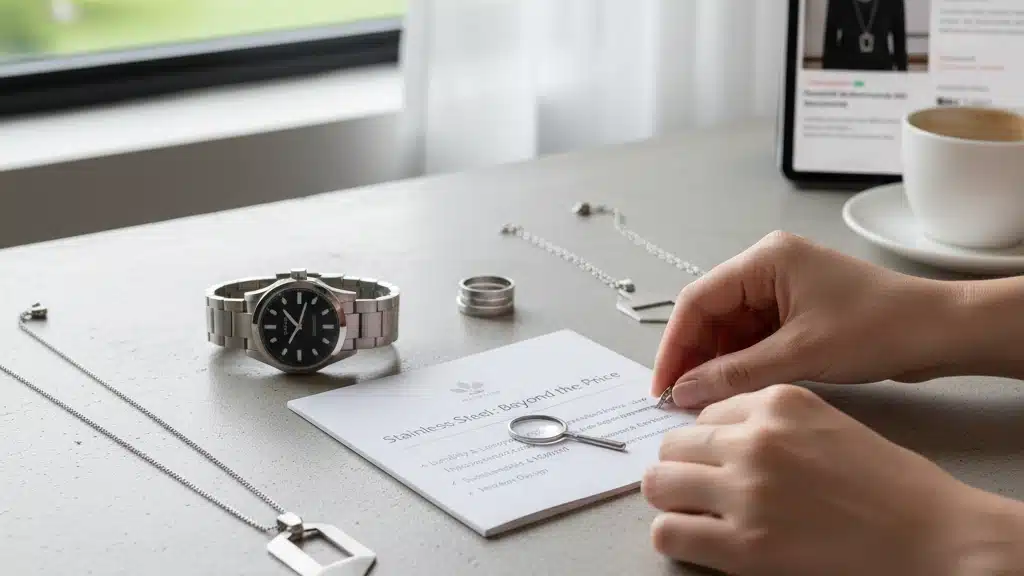
Τι Νοιάζει Πραγματικά τους Αγοραστές Ανοξείδωτου Κοσμήματος Εκτός από την Τιμή
Τι πραγματικά νοιάζει τους αγοραστές ατσάλινων κοσμημάτων πέρα από την τιμή ανθεκτικότητα υποαλλεργικά υλικά και μοντέρνο στυλ.
